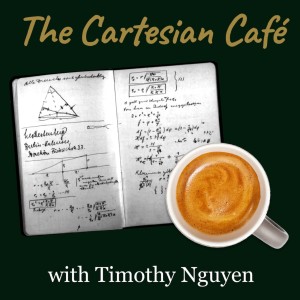
Tuesday Nov 22, 2022
Scott Aaronson | Quantum Computing: Dismantling the Hype
Scott Aaronson is a professor of computer science at University of Texas at Austin and director of its Quantum Information Center. Previously he received his PhD at UC Berkeley and was a faculty member at MIT in Electrical Engineering and Computer Science from 2007-2016. Scott has won numerous prizes for his research on quantum computing and complexity theory, including the Alan T Waterman award in 2012 and the ACM Prize in Computing in 2020. In addition to being a world class scientist, Scott is famous for his highly informative and entertaining blog Schtetl Optimized, which has kept the scientific community up to date on quantum hype for nearly the past two decades.
In this episode, Scott Aaronson gives a crash course on quantum computing, diving deep into the details, offering insights, and clarifying misconceptions surrounding quantum hype.
Patreon: https://www.patreon.com/timothynguyen
Correction: 59:03: The matrix denoted as "Hadamard gate" is actually a 45 degree rotation matrix. The Hadamard gate differs from this matrix by a sign flip in the last column. See 1:11:00 for the Hadamard gate.
Part I. Introduction (Personal)
- 00:00: Biography
- 01:02: Shtetl Optimized and the ways of blogging
- 09:56: sabattical at OpenAI, AI safety, machine learning
- 10:54: "I study what we can't do with computers we don't have"
Part II. Introduction (Technical)
- 22:57: Overview
- 24:13: SMBC Cartoon: "The Talk". Summary of misconceptions of the field
- 33:09: How all quantum algorithms work: choreograph pattern of interference
- 34:38: Outline
Part III. Setup
- 36:10: Review of classical bits
- 40:46: Tensor product and computational basis
- 42:07: Entanglement
- 44:25: What is not spooky action at a distance
- 46:15: Definition of qubit
- 48:10: bra and ket notation
- 50:48: Superposition example
- 52:41: Measurement, Copenhagen interpretation
Part IV. Working with qubits
- 57:02: Unitary operators, quantum gates
- 1:03:34: Philosophical aside: How to "store" 2^1000 bits of information.
- 1:08:34: CNOT operation
- 1:09:45: quantum circuits
- 1:11:00: Hadamard gate
- 1:12:43: circuit notation, XOR notation
- 1:14:55: Subtlety on preparing quantum states
- 1:16:32: Building and decomposing general quantum circuits: Universality
- 1:21:30: Complexity of circuits vs algorithms
- 1:28:45: How quantum algorithms are physically implemented
- 1:31:55: Equivalence to quantum Turing Machine
Part V. Quantum Speedup
- 1:35:48: Query complexity (black box / oracle model)
- 1:39:03: Objection: how is quantum querying not cheating?
- 1:42:51: Defining a quantum black box
- 1:45:30: Efficient classical f yields efficient U_f
- 1:47:26: Toffoli gate
- 1:50:07: Garbage and quantum uncomputing
- 1:54:45: Implementing (-1)^f(x))
- 1:57:54: Deutsch-Jozsa algorithm: Where quantum beats classical
- 2:07:08: The point: constructive and destructive interference
Part VI. Complexity Classes
- 2:08:41: Recap. History of Simon's and Shor's Algorithm
- 2:14:42: BQP
- 2:18:18: EQP
- 2:20:50: P
- 2:22:28: NP
- 2:26:10: P vs NP and NP-completeness
- 2:33:48: P vs BQP
- 2:40:48: NP vs BQP
- 2:41:23: Where quantum computing explanations go off the rails
Part VII. Quantum Supremacy
- 2:43:46: Scalable quantum computing
- 2:47:43: Quantum supremacy
- 2:51:37: Boson sampling
- 2:52:03: What Google did and the difficulties with evaluating supremacy
- 3:04:22: Huge open question
Homepage: www.timothynguyen.org
No comments yet. Be the first to say something!